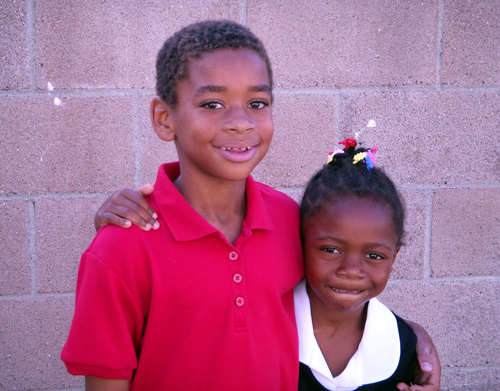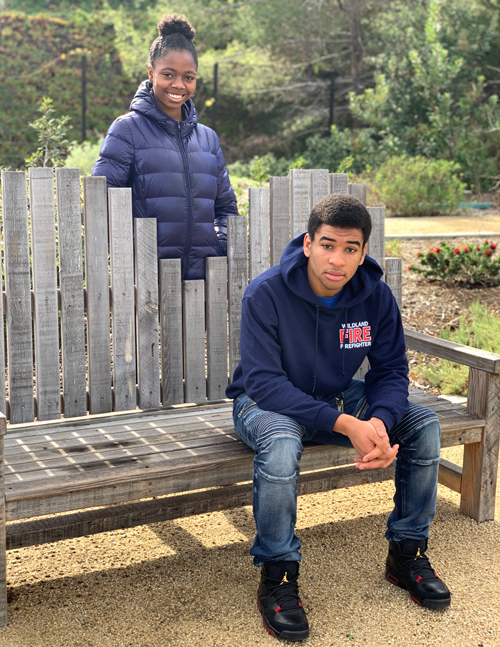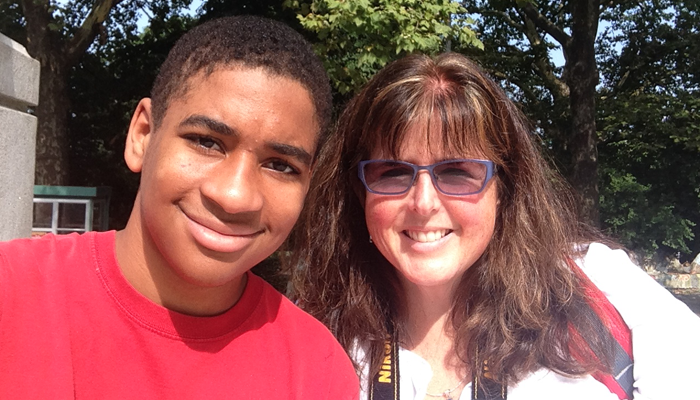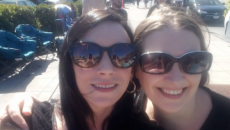[ABOVE: Author Rosemary Shulman with her son Matt, at age 16, on a vacation together in New York City.]
Seventeen years ago I wrote an article titled “Fostering Love” for Adoptive Families, when the magazine was still published in paper form. I read this magazine cover to cover while adopting my son, Matt, and I learned lots of helpful information. Matt was two years old when our story was first published and now he is a young man about to turn 20.
Growing My Family
Matt was healthy and thriving at age three and I wanted him to have a sibling. I updated my home study with our foster family agency. Right before Martin Luther King, Jr. Day in 2003, I had a strong feeling that that holiday weekend would be our last as a family of two. I wanted that weekend to be special. Since Matt was fascinated by transportation, I bought train tickets to San Francisco and we spent a wonderful weekend riding cable cars and streetcars. On Tuesday, I received “the call.” A five-day old baby girl was waiting for us. I finalized Bea’s adoption 14 months later.
Support Through Some Unexpected Blips
Matt’s first three years were unremarkable. He hit his major milestones on time or early. In hindsight, there were subtle signs of trouble ahead, especially once Matt started kindergarten. His growth began to slow down and he was the smallest child in the class. He struggled to sit still and pay attention. He began to display social immaturity. That year, Matt was diagnosed with ADHD.
It was immediately clear, on the other hand, that Bea would have challenges. The social workers disclosed that her toxicology screen was positive for cocaine. She was a sleepy baby with muscle stiffness, but she did not cry in pain from withdrawal. She struggled to suck and swallow, which hampered her weight gain. With the help of her pediatrician and lots of hard work, by three months, Bea was growing and alert. Sleep was a challenge from the beginning—and remains a struggle 16 years later. Bea was tiny for her age throughout infancy and childhood. She never had baby rolls and she remained below the tenth percentile for height, weight, and head circumference.
In California, infants with prenatal exposure qualify for the Early Start Program through a Regional Center. Regional Centers provide services for children and adults with developmental disabilities. The interventions helped Bea make steady progress. She walked at 13 months. As a toddler, she attended a program with typically developing peers. I can still picture her hanging out with the other girls on the tiny toilets, discussing the popular princesses. It was hilarious to listen to their chatter, and quite effective in helping her reach the potty-training milestone early!

Siblings Matt and Bea, ages 9 and 5, on their first days of third grade and kindergarten.
At age three, Bea was discharged from the Early Start Program to our school district. It was clear that she had a speech delay that required intervention. Our district required her to attend their special education preschool five hours per day in order to access speech therapy. I believed that the district was serving my child’s best interests and that they would continue the services she received from Early Start. I have since learned many hard lessons about special education.
Real-Life Lessons
- If your child qualifies for special education services, you need to learn the law (IDEA 2004). Wrightslaw.com is an excellent resource. Sign up for their newsletter and read everything on the site that is applicable to your child. I highly recommend attending their Advocacy and Law class.
- It is imperative to understand assessment scores and what your school district is required to include in their reports (such as tables with detailed scores).
- If your gut is telling you your child is struggling in school, listen.
- Act early. Request educational assessments in writing and include specific concerns.
- Become an expert in your child’s diagnosis/disability. Read everything you can and attend conferences.
Filling in the Blanks
I was fortunate to receive detailed documents and a complete history for my daughter. Even so, she wouldn’t be diagnosed with Fetal Alcohol Syndrome, the most severe Fetal Alcohol Spectrum Disorder (FASD), and an intellectual disability until she was eight. All of her early care providers dismissed the one sentence in a social worker’s report to the judge that indicated that Bea’s birth mother drank alcohol throughout her pregnancy.
Several years after Bea’s diagnosis, I attended an FASD conference. As the speaker discussed symptoms, light bulbs began exploding in my head. Every symptom was applicable to Matt. How in the world could I have missed it for so many years? In hindsight it was not hard. Bea’s symptoms are more severe, and Matt does not have an intellectual disability. Social workers never mentioned his prenatal alcohol exposure and there was nothing about it in his documented history.
In fact, my son’s placement papers were nearly blank. He has many siblings, all of whom were in the system over a period of 14 years, and disclosure is required by law in our state. There was no justification provided for the blank documents. I received history and referral pamphlets about an uncle’s disease, but no information about his birth parents. My son tested negative at birth for the uncle’s disease. I was naïve, my son was thriving, and I just wanted the adoption to be finalized. I did not question anything and agreed to the basic adoption assistance program (AAP) rate.
Real-Life Lessons
- If you suspect that your child has medical, developmental, or behavioral challenges that have not been diagnosed and addressed before the adoption process begins, request full assessments before you proceed.
- Don’t rush the process or let anyone else rush you through. It is hard to wait, but the information from current assessments and full disclosure of his or her birth family history will help your child for years to come.
- Do not sign placement papers until your concerns are addressed and your child has been assessed. You can’t plan for what may happen in the future, but you can prepare for what you know.
- Early Intervention (EI) is key. [Find your state’s Early Intervention program.]
- The placement papers include an AAP agreement. The rate needs to be based on the child’s needs. This is not about profiting from your adoption. Medical care and therapy are incredibly expensive.
- Your child’s needs may change. You can request an increase of the AAP as needed. Be prepared to provide documentation of the increased need from physicians and therapists.
- Once your adoption is final, you can focus on using these resources to care for you child rather than struggling to make ends meet.
- Learn parenting strategies that accommodate your child’s special needs. I think of this as “using a different parenting handbook.”
Birth Family Connections
I was fortunate to have met several of Matt’s extended birth family members at court proceedings. Not only did they confirm what I suspected, they were willing to put what they knew and witnessed in terms of prenatal exposure in writing. Matt was finally diagnosed with FASD at age 15.
Real-Life Lessons
- Nurture birth family connections if you have the opportunity to meet them during foster placement.
- Keep in touch as much as possible, as long as the relationships are healthy for your child. You never know when you might need family social and medical history.
- Include birth relatives in your child’s life, even if in conversation only. Acknowledge them during holidays, milestone events, and prayers.
- Ask your social workers for photographs of birth family members, especially siblings. Scan them and keep them safe. Your children will want them.
- If you’re able to visit, take plenty of photos of your children with their birth family members.
- Write down stories and facts they share during visits. Share these gems with your child.
Life with FASD
Once I learned of Bea’s diagnosis, I became proactive. Rather than dwelling on her intellectual disability and the lifelong implications that I could not change or fix, I found appropriate supports and programs that have provided us with happy childhood memories.
Real-Life Successes
- Bea has participated in Special Olympics for the past eight years.
- I found a local sleepaway camp that was willing to assign Bea to a cabin with girls her developmental age, rather than her biological age.
- Matt and I love to travel, but it is difficult for Bea. Flying, in particular, was a huge source of anxiety for her. Since we live in a port city, we cruised on our vacations instead.
- I invite friends and family who understand my children’s invisible disabilities to travel with us. As a single parent, having another adult on hand also allowed the kids to split up, so each could participate in activities that interested him or her.
Once I knew that Matt had FASD, I began using my “different parenting handbook” with him too. Family life improved dramatically. For years, Matt struggled in school, and at one point I did not think he would be able to finish. Once he was properly diagnosed and moved to the right school environment, he flourished. He earned his diploma last year and he is about to complete the first year of a two-year job training program, which he has successfully attended on his own out-of-state.
My son will always face some challenges due to his FASD, however, with a few basic supports in place, he will be able to work and support himself. In short, the sweet little boy I wrote about years ago is thriving, and I am one proud mom.

Bea and Matt, ages 16 and 19, hanging out at the Nature Center near their house. Matt is currently a wildfire firefighter, and was home for the holidays.
We Are on The Path Less Traveled
I have not lived the life I dreamed of when I sat down to write about adopting Matt, 17 years ago. Like all families we have faced adversity. Our successes look different, but we have them. I value and appreciate life’s unexpected little victories. I focus on my children’s strengths and interests rather than dwell on what will never be. We have an adventure filled life, a different life as a forever family.
ROSEMARY SHULMAN is a mom to a teen daughter and a young adult son adopted from foster care. Both of her children live with a Fetal Alcohol Spectrum Disorder. She shares what she has learned about parenting differently on her blog, Invisible in Plain Sight. Rosemary teaches parents, educators, social workers, and medical providers about FASD and actively volunteers on the board of the FASD Network of Southern California.


